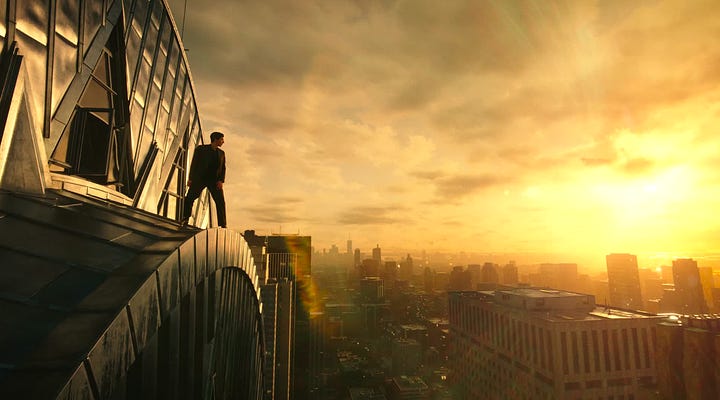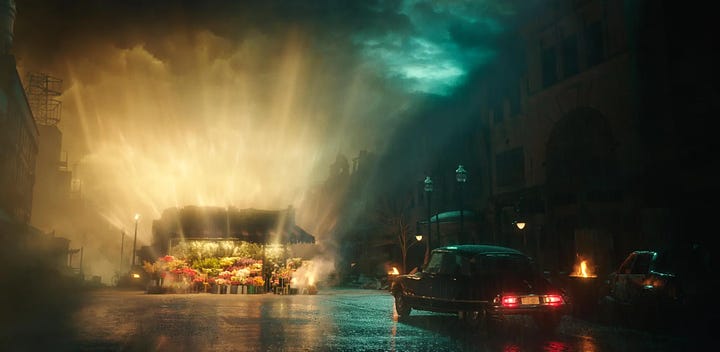OVERVIEW:
This essay examines Francis Ford Coppola’s Megalopolis, a sprawling and ambitious film that dares to critique both human society and the current state of cinema. The review begins with a vivid account of a special screening in Hanoi, highlighting the film’s immersive visuals and experimental editing. It delves into the film’s narrative, which draws parallels between the fictional New Rome and both ancient decadence and modern-day political and cultural divides.
While addressing controversies surrounding Coppola’s alleged anti-woke stance, the essay rejects reductive readings of the film’s politics, emphasizing its origins in the 1980s and its broader themes of unity and artistic vision. Drawing comparisons to Ayn Rand’s Anthem and Petronius’s The Satyricon, the review situates Megalopolis as a biting satire of societal decadence and a reflection on cinema’s current vacuousness. Ultimately, the essay celebrates Coppola’s flawed masterpiece as both a critique of the medium’s present indulgence in spectacle and a hopeful gesture toward its potential for depth and innovation.
Under the neoclassical grandeur of its Opera House transformed into an IMAX theater in Hanoi over the weekend, I attended a screening of Francis Ford Coppola’s Megalopolis—it was almost an experience that felt like stepping into an alternate cinematic reality. This was no ordinary viewing; hosted by a French Arts Council in Vietnam, the event included extensive lectures on Coppola’s oeuvre, dissecting masterworks, each in their own way, from The Godfather (1972), Apocalypse Now (1979), The Conversation (1974), and One from the Heart (1981). The screening featured an extended cut unseen in the West, and the audience—suited, elegant, and reverent—added to the air of significance. Yet even amidst this heightened atmosphere, the film itself loomed larger, an audacious, flawed masterpiece that dares to grapple with the past and future of cinema. There was a keen sense of excitement around this delayed Vietnamese premiere.
At its heart, Megalopolis unfolds in an alternate United States, where New Rome is ruled by patrician elites cloaked in moral righteousness, but steeped in decadence. The film centers on Adam Driver’s Cesar Catilina, a visionary architect who wins a Nobel Prize for inventing Megalon, a revolutionary building material. Despite his professional acclaim, Cesar is haunted by personal tragedy: his wife’s suicide and the malicious prosecution by his adversary, Mayor Franklyn Cicero (enacted wonderfully, in my opinion, by Breaking Bad’s (2008-2013) Giancarlo Esposito. When Cesar proposes building a utopian city, Megalopolis, his vision collides with Cicero’s pragmatic agenda, igniting a battle of ideologies that spirals into personal betrayals and societal collapse.
Visually, the film is a marvel. The CGI evokes the charm of old matte paintings, blending seamlessly with opulent, hyper-detailed sets that transport viewers into Coppola’s richly imagined New Rome. Cinematographer Mihai Mălaimare Jr., best known for The Master (2012), bathes the film in amber and blue hues, creating a visual language that feels both classical and otherworldly. These hues lend a dreamlike quality to a city that teeters between grandeur and ruin.
Editor Cam McLauchlin also delivers moments of sheer brilliance, employing split screens to juxtapose the construction of New Rome along with vivid montages of food preparation, fiery chaos, and even a reel of film burning—a visceral metaphor for the precarious, at this point almost “existential” state of cinema itself in our present age. These edits culminate in sequences of surreal drug hallucinations and chaotic urban imagery, blurring the lines between Cesar’s vision and reality. Watching these moments unfold in Hanoi’s Opera House—with its historic elegance juxtaposed against the frenetic modernity of Coppola’s style—was a wholly singular experience.


Osvaldo Golijov’s score is lush and ambitious, veering between inspiring grandeur and sentimental excess. The music amplifies the film’s emotional stakes, but it sometimes risks tipping moments into melodrama. That tension—between the film’s earnest self-seriousness and its occasionally stilted dialogue—is part of what makes Megalopolis so fascinating. The exchanges between characters often feel like relics from Old Hollywood, their heightened, unnatural cadence imbuing the film with the gravitas of a fable. This is a story that takes itself seriously, and while that might alienate some, it feels like a deliberate choice—an Old Hollywood epic cloaked as a postmodern critique of modern cinema.




For better or for worse, I have always been drawn to such controversial projects: works that provoke strong reactions and polarize audiences. Megalopolis is no exception, and the discourse surrounding it has been as grandiose and conflicted as the film itself.
The film is steeped in controversy, and much of the publicity surrounding the film has centered on that controversy, targeting Coppola himself. Allegations of his “anti-woke” stance and inferred “extreme right-wing” politics have drawn criticism, particularly in the United States, where the shadow of Trumpism still looms large. Europe, too, has long harbored fears of the ideological currents tied to Trump’s 2016 rise to presidency of the free world. But such readings of Megalopolis risk misrepresenting the film’s origins and intentions. Coppola conceived the idea for this sprawling narrative in the early 1980s, during his immediate post-Apocalypse Now (1979) phase. To judge it solely through the lens of contemporary politics is not only reductive but absurd, erasing decades of artistic gestation in favor of shallow partisanship.
Art, regardless of political alignment, exists to provoke thought, not dictate belief. Megalopolis embraces a universalism that transcends ideology, underscored by its climactic declaration:
I pledge allegiance to our human family, and to all the species that we protect. One Earth, indivisible, with long life, education and justice for all.”
Like the aspirational lines in Ayn Rand’s Anthem (1937):
My happiness is not the means to any end. It is the end . . . I owe nothing to my brothers, nor do I gather debts from them
Coppola’s film seeks not to polarize but to unite through grand, ambitious storytelling. As a teacher, I’ve seen Rand’s shorter works like Anthem inspire students to think critically about individuality and societal structures—not as manifestos, but as vehicles for intellectual engagement. Megalopolis accomplishes something similar, offering a framework for reflection that transcends narrow ideological boundaries. Ayn Rand’s bravery was forged in the crucible of the Soviet Union, where she rejected collectivist ideology to champion radical individualism, while Francis Ford Coppola’s courage in Megalopolis emerges from his defiance of a Hollywood he perceives as increasingly prudish and restrictive, daring to push the boundaries of artistic and ideological expression in an era of creative caution.


The literary work that the film reminds me most of, however, is The Satyricon. Written by Petronius, an advisor to Emperor Nero, in the 1st century CE, The Satyricon is a fragmented yet biting satire of Roman society at the height of its decadence. Petronius skewers the pretensions and hypocrisies of the elite, exposing a culture obsessed with wealth, spectacle, and moral posturing. Coppola’s Megalopolis channels this same satirical impulse, offering a vision of New Rome that mirrors the absurdities and inequalities of its ancient predecessor. The patrician elites of Megalopolis, much like Petronius’s characters, are riddled with contradictions, professing high ideals while indulging in every excess.
This comparison underscores the film’s timelessness and its critique of the state of cinema itself: its vacuousness, its indulgence in spectacle, and its yearning for the depth it has seemingly abandoned. In Megalopolis, Coppola gestures toward the possibility of a medium renewed, capable of once again shouldering profound and daring ideas as it ventures into the future.




